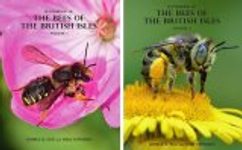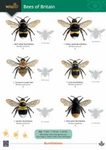Rufen Sie uns an (9:30 - 18:00 DE)
+44 (0) 1803 86 59 13International
+44 (0) 1803 86 59 13Brauchen Sie Hilfe?
HilfeDatenerfassung und Monitoring
- Aquatic Survey & Monitoring
- Professional Hand & Kick Nets
- Water Testing
- Waders & Aquatic Safety
- View All
- Amphibian & Reptile Survey
- Amphibian Survey & Monitoring
- Reptile Survey & Monitoring
- Scales, Balances & Holding Bags
- View All
Feldführer und Naturgeschichte
Akademische und professionelle Bücher
- Evolutionary Biology
- Evolution
- Human Evolution & Anthropology
- Cladistics, Phylogeny & Taxonomy
- View All
British Wildlife
British Wildlife is the leading natural history magazine in the UK, providing essential reading for both enthusiast and professional naturalists and wildlife conservationists. Published eight times a year, British Wildlife bridges the gap between popular writing and scientific literature through a combination of long-form articles, regular columns and reports, book reviews and letters.
Conservation Land Management
Conservation Land Management (CLM) ist ein Mitgliedermagazin und erscheint viermal im Jahr. Das Magazin gilt allgemein als unverzichtbare Lektüre für alle Personen, die sich aktiv für das Landmanagement in Großbritannien einsetzen. CLM enthält Artikel in Langform, Veranstaltungslisten, Buchempfehlungen, neue Produktinformationen und Berichte über Konferenzen und Vorträge.





![Hymenoptera Apoidea de Madagascar et des îles Voisines [Hymenoptera: Apoidea of Madagascar and Neighbouring Islands] Hymenoptera Apoidea de Madagascar et des îles Voisines [Hymenoptera: Apoidea of Madagascar and Neighbouring Islands]](http://mediacdn.nhbs.com/jackets/jackets_resizer_xlarge/14/148821.jpg?height=620)
![Hymenoptera Apoidea de Madagascar et des îles Voisines [Hymenoptera: Apoidea of Madagascar and Neighbouring Islands]](http://mediacdn.nhbs.com/jackets/jackets_resizer/14/148821.jpg)
![Hymenoptera Apoidea de Madagascar et des îles Voisines [Hymenoptera: Apoidea of Madagascar and Neighbouring Islands]](http://mediacdn.nhbs.com/jackets/jackets_resizer/14/148821_1.jpg)
![Hymenoptera Apoidea de Madagascar et des îles Voisines [Hymenoptera: Apoidea of Madagascar and Neighbouring Islands]](http://mediacdn.nhbs.com/jackets/jackets_resizer/14/148821_2.jpg)
![Hymenoptera Apoidea de Madagascar et des îles Voisines [Hymenoptera: Apoidea of Madagascar and Neighbouring Islands]](http://mediacdn.nhbs.com/jackets/jackets_resizer/14/148821_3.jpg)
![Hymenoptera Apoidea de Madagascar et des îles Voisines [Hymenoptera: Apoidea of Madagascar and Neighbouring Islands]](http://mediacdn.nhbs.com/jackets/jackets_resizer/14/148821_4.jpg)
![Hymenoptera Apoidea de Madagascar et des îles Voisines [Hymenoptera: Apoidea of Madagascar and Neighbouring Islands]](http://mediacdn.nhbs.com/jackets/jackets_resizer/14/148821_5.jpg)





![Les Poissons du Lac Tumba et de la Région d'Ikela: Etude Systématique et Écologique [The Fish of Lake Tumba and the Ikela Region: Systematic and Ecological Study]](http://mediacdn.nhbs.com/jackets/jackets_resizer_medium/14/148546.jpg?height=150&width=100)
![Faune des Poissons d'Eaux Douces de la Réserve de la Biosphère de Dimonika (Mayombe, Congo) [Fauna of the Freshwater Fishes of the Dimonika Biosphere Reserve (Mayombe, Congo)]](http://mediacdn.nhbs.com/jackets/jackets_resizer_medium/14/148793.jpg?height=150&width=107)








![Révision des Characidae Nains Africains [Revision of African Dwarf Characidae]](http://mediacdn.nhbs.com/jackets/jackets_resizer_medium/14/148604.jpg?height=150&width=99)













![Mai-Ndombe: Mosaïque de Peuples Établie sur un Patrimoine Naturel [Mai-Ndombe: Mosaic of Peoples Established on a Natural Heritage]](http://mediacdn.nhbs.com/jackets/jackets_resizer_medium/24/249964.jpg?height=150&width=106)





![Reptiles Récoltés au Congo par le Dr. H. Schouteden et M. G.-F. de Witte [Reptiles Collected in the Congo by Dr. H. Schouteden and M. G.-F. de Witte]](http://mediacdn.nhbs.com/jackets/jackets_resizer_medium/14/148319.jpg?height=150&width=115)

![Mongala: Jonction des Territoires et Bastion d'une Identité Supra-Ethnique [Mongala: Junction of Territories and Bastion of a Supra-Ethnic Identity]](http://mediacdn.nhbs.com/jackets/jackets_resizer_medium/25/250908.jpg?height=150&width=106)
